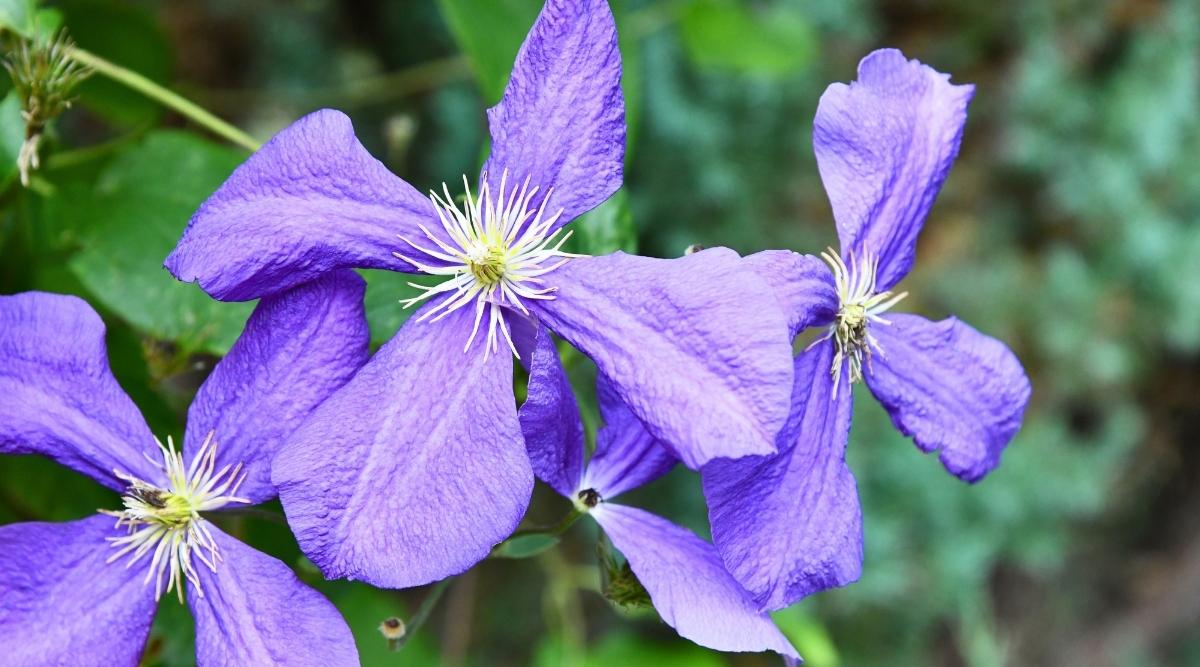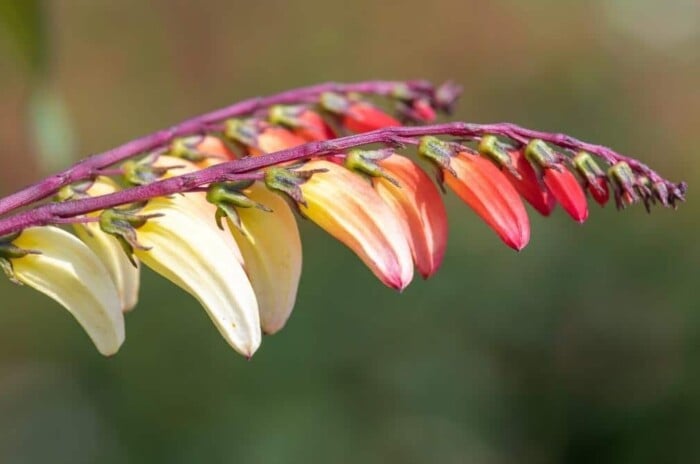11 Beautiful Vines With Purple Flowers
Thinking of planting some vines this season but want to make sure they have purple flowers? The good news is you have plenty of options, as many vines and climbers have purple flowers. In this article, you'll learn all about our favorite purple flowered vines, and where they can grow!

Contents
Looking to add some vines or climbers to your yard, but want to make sure they have purple flowers before you start planting? Good news—there are plenty of beautiful options to choose from. Many of these purple-flowered vines are fast growers, meaning you can often see them cover their intended space in just a single season.
If you have an arbor or trellis in your backyard, these plants are perfect for creating a lush, green focal point. You can train them to grow over various structures for decoration, and some can even climb walls if they have the proper support.
Keep in mind that a few of the vines we’ll cover may be a bit too vigorous or invasive for some gardens. However, with regular pruning and maintenance, they can still work beautifully as ornamental plants.
Let’s dive in and explore some of our favorite purple-flowered vines to grow in your home garden!
Blue Sky Vine

|
|
botanical name Thunbergia grandiflora |
|---|---|
|
|
sun requirements Full sun to partial shade |
|
|
height 6 to 8 feet |
|
|
hardiness zones 10-11 |
The blue sky vine features large, trumpet-shaped blossoms, typically around three inches in diameter. A tropical perennial, its pale blue-purple flowers with yellow throats attract butterflies, bees, and hummingbirds, bringing life and movement to your garden. While not as commonly planted as clematis or other well-known vines, it’s a stunning and underrated choice.
Despite the name, the blue sky vine tends to produce soft, lilac-toned blooms rather than true blue. Its close relative, the blue glory vine, produces a more vibrant blue flower, veering away from the purplish hues.
Though native to tropical regions, the blue sky vine is surprisingly hardy and can return after winter in many climates. It’s well suited to climbing medium to large trellises, arbors, or even metal fences. It also performs well in containers and can be grown indoors with enough light.
Bougainvillea

|
|
botanical name Bougainvillea spectabilis |
|---|---|
|
|
sun requirements Full sun |
|
|
height 15 to 40 feet |
|
|
hardiness zones 9-11 |
These vines with purple flowers are known for vibrant colors, which also include orange, red, and pink. Interestingly, the true flowers of the bougainvillea are small and white, but they’re surrounded by large, colorful bracts (modified leaves) that give the plant its iconic bursts of color.
This dense, woody vine blooms from early spring through fall, offering months of eye-catching display. As one of the most brilliant purple-flowering vines available, bougainvillea is a fantastic choice for gardeners who love bold color. However, keep in mind that in some regions, it’s considered invasive and may require regular maintenance to keep it in check.
Clematis

|
|
botanical name Clematis viticella |
|---|---|
|
|
sun requirements Full sun to partial shade |
|
|
height 10 to 15 feet |
|
|
hardiness zones 4-8 |
The purple-flowering clematis vine features star-shaped blossoms that typically bloom in the height of summer. Using tendrils to climb, clematis can scale metal fences, trellises, walls, or even poles with ease.
One of the hardiest climbing vines, clematis grows quickly and thrives even in cooler climates. Though it originates from China and Japan, it’s also a beloved garden staple in places like England. With over 300 species and countless hybrids, clematis is a highly versatile vine suitable for a wide range of garden styles.
Many gardeners are drawn to clematis hybrids for their show-stopping blooms, which bring a whimsical, almost magical touch to backyard arbors and garden structures.
Dutchman’s Pipe

|
|
botanical name Aristolochia gigantea |
|---|---|
|
|
sun requirements Full sun to partial shade |
|
|
height 15 to 30 feet |
|
|
hardiness zones 10-12 |
Though not the first choice for many gardeners seeking purple-flowering climbing vines, Dutchman’s pipe is a unique and eye-catching option that can help your garden stand out. The name “Dutchman’s pipe” comes from the flower’s distinctive shape, which resembles a traditional Dutch smoking pipe.
The blooms feature a greenish-yellow base flower, surrounded by two to three lobes in a rich maroon-purple shade. This vine prefers consistently moist soil and does not perform well in dry conditions.
While these vines with purple flowers look stunning winding around fences, walls, or trellises, it’s important to note that they can be toxic if consumed. This is definitely a plant to admire from a distance—not one to nibble on.
Hyacinth Bean Vine

|
|
botanical name Lablab purpureus |
|---|---|
|
|
sun requirements Full sun |
|
|
height 10 to 25 feet |
|
|
hardiness zones 10-11 |
The hyacinth bean vine is a thick, dense grower with burgundy stems and pale purple bracts. Its large, leafy canopy provides plenty of shade, while the deep purple bean pods stand out as a striking feature of the plant.
Although it grows rapidly, the hyacinth bean vine is non-invasive. You can plant it in a specific spot (such as near a trellis or arbor) and trust that it will fill in the space without spreading uncontrollably. It climbs quickly and creates a lush, draping effect, but it won’t creep into other areas of your garden.
While the young blooms and some parts of the plant are considered edible, mature or dried beans from the hyacinth bean vine are toxic. If you’re looking to keep your garden completely pet- or child-safe, this may not be the best choice.
Lavender Trumpet Vine

|
|
botanical name Clytostoma callistegioides |
|---|---|
|
|
sun requirements Full sun to partial shade |
|
|
height 15 to 20 feet |
|
|
hardiness zones 9-11 |
Woody vines with purple flowers and dense foliage, the lavender trumpet vine produces blossoms that live up to its name. These trumpet-shaped flowers measure around three inches wide and feature soft purple hues, adding a lovely pastel tone to any garden.
Thanks to its vigorous growth and dense vines, the lavender trumpet vine climbs easily over nearly any surface, whether it’s a trellis, fence, telephone pole, or even the side of a house. However, this same density can lead to problems if left unchecked. Without regular pruning, the vine may overwhelm its support structure or spread into unwanted areas, including neighboring yards or natural habitats.
To keep it under control, consistent pruning is essential. With the right care, these vines with purple flowers can be a stunning and manageable addition to your garden.
Morning Glory

|
|
botanical name Ipomoea purpurea |
|---|---|
|
|
sun requirements Full sun |
|
|
height 6 to 10 feet |
|
|
hardiness zones 2-11 |
Named for its blooming habit, the morning glory vine unfurls its blossoms early each day and closes them again by evening. With thousands of varieties to choose from, it’s a highly versatile plant suitable for many garden styles.
The trumpet-shaped blooms are typically one to two inches in diameter, often in shades of purple tinged with blue, creating beautiful tones of indigo or deep violet. Viewed head-on, the flowers display a distinctive star-shaped pattern at their center.
Morning glories are drought-tolerant and self-seeding, which makes them easy to grow but also potentially invasive if not managed carefully. With proper cultivation and regular maintenance, you can limit the vine’s spread and enjoy its vibrant color in a controlled area. Keep in mind that the seeds are toxic, so it’s important to keep them away from pets and children.
Nightshade

|
|
botanical name Solanum xanti |
|---|---|
|
|
sun requirements Full sun to partial shade |
|
|
height 2-3 feet |
|
|
hardiness zones 8-10 |
Purple nightshade are shrubby vines with purple flowers that can climb nearby structures like fences, offering both ornamental appeal and natural resilience. It produces distinctive star-shaped flowers with flared purple petals surrounding a bright yellow pistil, similar to other nightshade species.
Like many other purple-flowering climbers, purple nightshade is toxic. Its poisonous nature makes it unpalatable to grazing animals, particularly deer. For this reason, some gardeners use purple nightshade strategically as a natural deterrent to help protect the rest of their garden from browsing.
Passion Vine

|
|
botanical name Passiflora spp. |
|---|---|
|
|
sun requirements Full sun to partial shade |
|
|
height 6 to 30 feet |
|
|
hardiness zones 6-10 |
The passion vine produces the stunning and uniquely structured passionflower, named for the Passion of Christ. While often grown for ornamental purposes, many species also produce edible passionfruit.
Passionflowers are easily recognized by their intricate structure, featuring ten petals, three prominent stigma, and a ring of radial filaments that often appear in shades of pale purple or indigo. Their striking appearance makes them a standout addition to any garden.
Gardeners typically train passion vines over trellises or arbors to showcase their dramatic, tropical-looking blooms. Although they thrive in tropical and subtropical regions, many varieties are surprisingly hardy and can be grown in climates as cool as USDA zone 6.
Twining Snapdragon

|
|
botanical name Antirrhinum kelloggii |
|---|---|
|
|
sun requirements Full sun to partial shade |
|
|
height 1 to 3 feet |
|
|
hardiness zones 8-10 |
Though not a true vine, the twining snapdragon climbs other plants and surfaces in a vine-like fashion. Its flowers retain the characteristic shape of traditional snapdragons, with a distinctive snout and mouth-like appearance.
Twining snapdragon blooms are typically indigo or deep purple, sometimes accented with hints of blue or white. The plant has slender, delicate stems that twine and cling to nearby supports, giving it a more compact and graceful growth habit.
If you don’t have space for a traditional trellis or prefer a lighter climber over denser, woodier vines, the twining snapdragon makes an excellent alternative, especially when grown among other plants it can gently weave through.
Wisteria

|
|
botanical name Wisteria spp. |
|---|---|
|
|
sun requirements Full sun to partial shade |
|
|
height 30 to 60 feet |
|
|
hardiness zones 5-9 |
Wisteria is a woody, twining vine known for its cascading clusters of lavender-purple flowers. Due to its vigorous growth and twining habit, wisteria requires sturdy support (such as a pergola, arbor, or heavy-duty trellis) to thrive. With regular pruning, gardeners can keep wisteria under control and encourage strong, beautiful growth.
In areas where the China native (Wisteria sinensis) is invasive, opt for the North American native instead (Wisteria frutescens). When in bloom, the flowers resemble cone-shaped brushes, made up of many small blossoms densely packed along the vine. While the blooms are most often purple, some varieties display shades of blue, pink, or white.
Though wisteria is best known for flourishing in full sun, it can also be a striking addition to shade gardens in the right hardiness zones, making it a flexible and dramatic vine with purple flowers for vertical spaces.









